While 3 days in Porto is enough to see the highlights, consider adding an extra day or two in your itinerary to lounge on one of the scenic beaches nearby or just sip more port at sunset.
The beautiful coastal village of Porto on the Douro River stole my heart in no time with its Eiffel Tower-inspired bridges, traditional wooden Rabelo boats, and intricate tile everywhere.
It’s also a great European getaway in winter. You’ll feel like you’re walking through a charming painting here!
Is Porto worth visiting? Absolutely! It was my favorite city in Portugal. How many days in Porto? Read on, then decide!
Your Porto Travel Guide: The Best Porto Itinerary
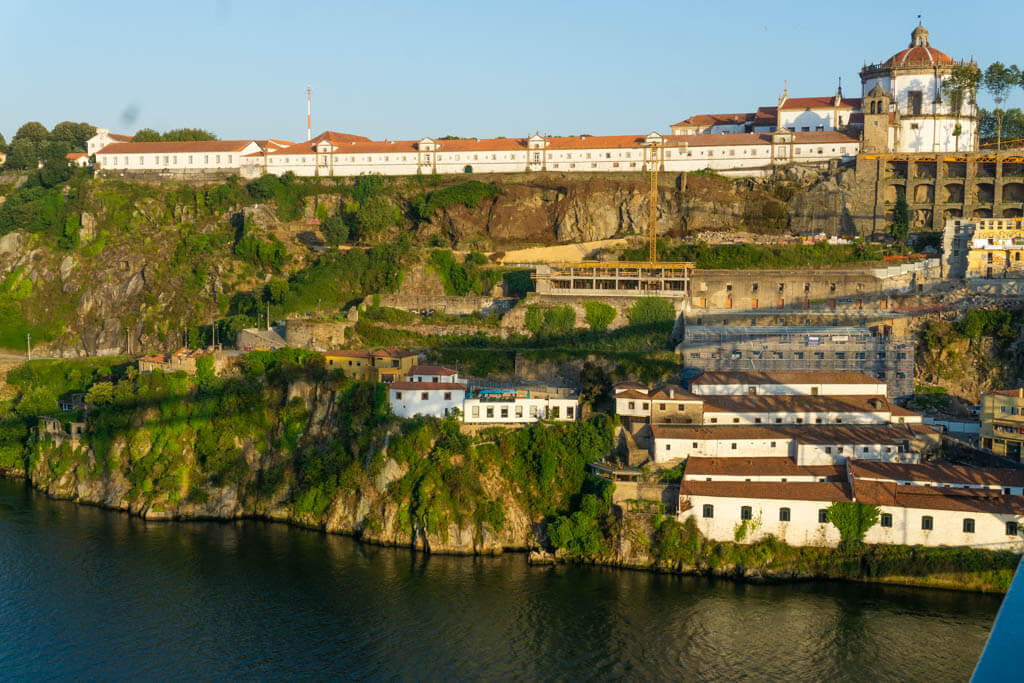
To make the most of your Porto 3 day itinerary, consider a hop-on hop-off bus tour. Or even a yellow bus tour.
I never understood how wonderful these were until I had the experience myself in Barcelona.
It’s a great way to see a lot in a limited time and get a nice orientation to a city. If you want to add one to your Porto itinerary, you can check prices here.
Where to Stay in Porto: Top Neighborhoods
The short answer: If you want to be fairly central for walking Porto, your best bet is to choose lodging in the Centro/Aliados or Bolhão neighborhoods as you’ll be close to restaurants and nightlife.
Here’s a bit more about popular areas to stay:
1. Centro-Baixa is a favorite for travelers. It’s in the historic center. You’ll find the beautiful tiled São Bento Railway Station here as well as the Church dos Clerigos with it’s famous tower.
2. Ribeira is the center of old town and has been a UNESCO site since 1996! Its bright, multi-storied buildings here stretch along the Duoro River and open onto terraces with lots of outdoor seatings.
The Praca da Ribeira is the hub of this beautiful area; it’s where the nightlife is in Poto.

Ribeira is Porto’s prettiest waterfront neighborhood…oozing ambiance (and tourists). Be aware that it can be loud at night and will require a steep, steep walk up to reach the rest of Porto.
3. Miragaia is another historic neighborhood with medieval origins. It used to be the “suburbs” outside the city in days gone by and was home to many local Jews and Armenians.
You’ll find lots of steep streets to climb (but then, that’s true all over Porto). Couples and families often stay here to enjoy the galleries, restaurants, and markets in the colorful area.
4. Bolhão is the heart of the center of Porto. We loved our stay here and fewer tourists helped us enjoy Porto like locals. You’ll find Bolhão between Rua de Santa Cataria (a famous street for shopping) and Avendia dos Aliados.
It’s easy to walk throughout the city center by basing here. There are dozens of delicious restaurats and many gorgeous tiled building facades. See below for my lodging recommendations.
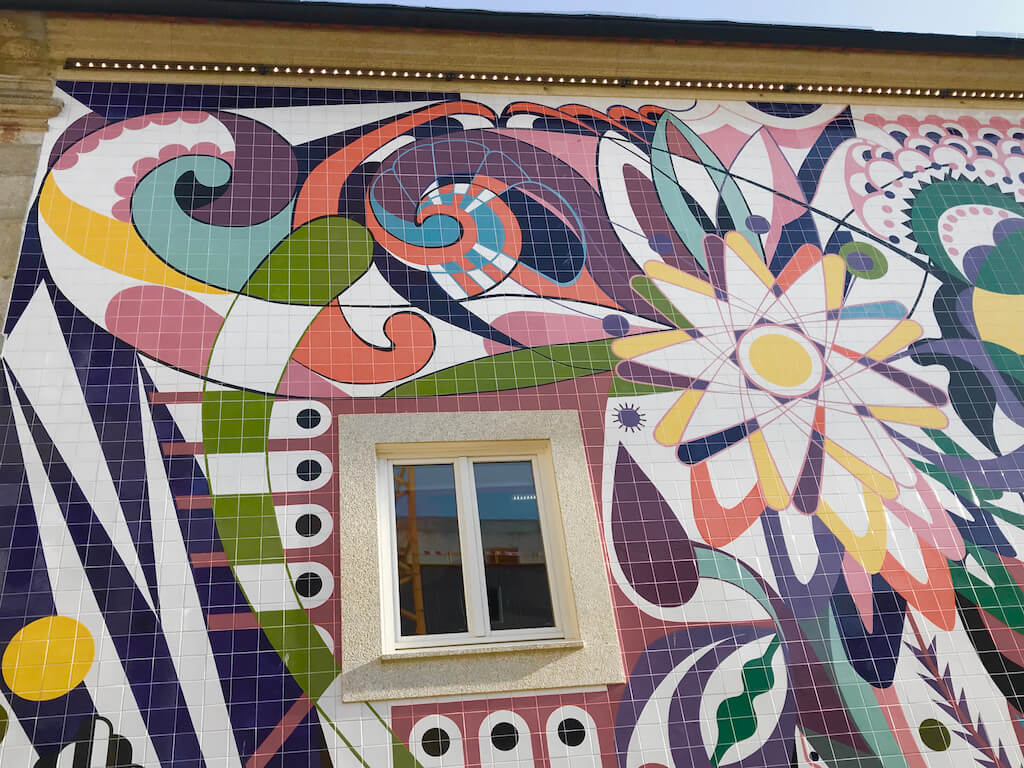
Where to Stay in Porto: My Recommendations
1. Infante Sagres Hotel
Stay here if you love the idea of ensconcing yourself in stylish, old-world elegance!
This historic 5-star hotel in a hip area of the Aliados neighborhood features neo-baroque and custom-made furnishings and is decorated with antique chandeliers. It comes with sundeck, plunge pool and a beautiful breakfast too!z
A perfect choice for luxury lovers looking for a vibrant, central location. Be aware that there can be a bit of street noise as a result and there is no gym on-site. You can check prices and availability here.
2. Bolhão Central Loft
Looking for a beautiful loft on a budget?
Stay in a brand new loft in the city center just across from the mythical Bolhão Market. Watch the world go by from your colorful tiled balcony. Perfect for your long Porto weekend itinerary – or any time of the week!
Guest review: “The apartment was exceptionally clean and comfortable and Luis was an extremely kind and helpful host. The apartment is modern and bright and the small terrace is an added bonus!
You can check prices and availability on the Bolhão Central Loft here.
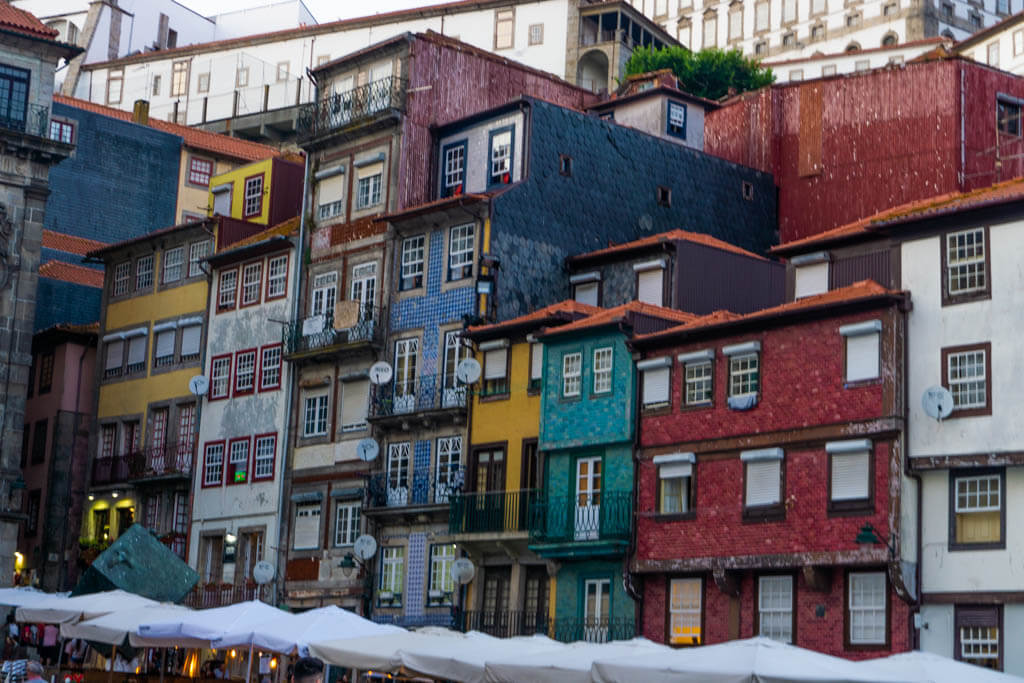
Porto in 3 Days
Porto got its name way back in the 4th century when it was an outpost for the Roman empire; “Porto” is derived from its Latin-Celtic name: “Portus Cale.”
Later, when it became a major commercial trading port, Europeans began calling it “OPorto” after they misunderstood that locals were using the article “o”—”the”—in front of the name.
The name stuck and it’s still a source of annoyance to some locals!
The city used to also go by the name “Invicta” or “Invincible” because it was never conquered by the Moors or other invaders that attacked Portugal and Spain throughout the millennia.
As a result, Porto has a long tradition of fierce independence.
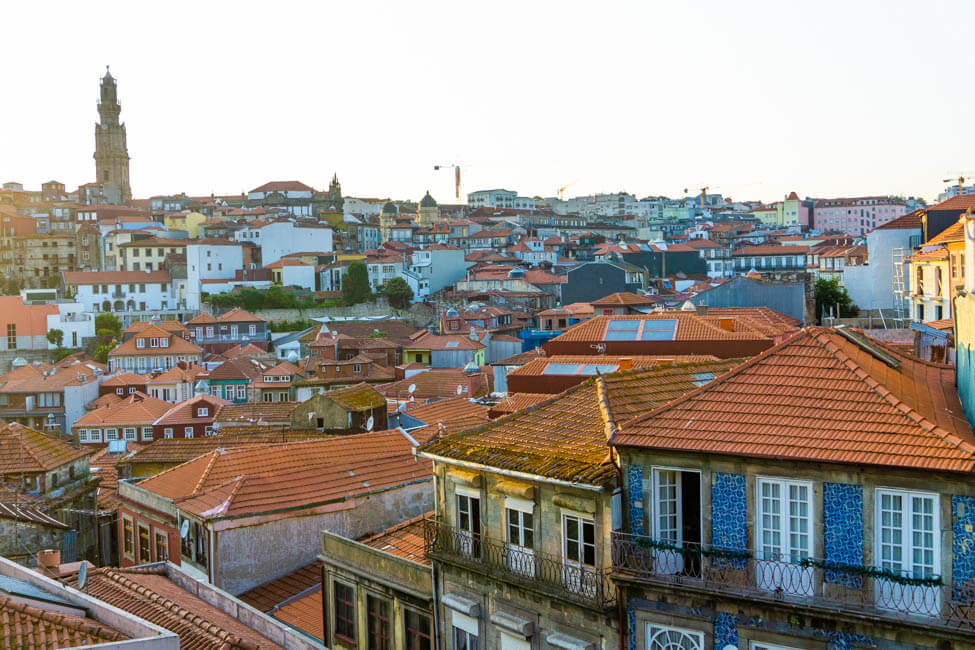
Residents see themselves as a little more authentic and “rough and tumble” than Lisbon city folk.
After all, the whole country—”Portugal”—took its name from Porto. (Lisbon or Porto? It’s tough to decide. It’s true there are many, many things to do in Lisbon.)
Lisbon is steep, hilly, and sprawling; Porto a little less hilly, but more compact and walkable.
Lisbon is all about the “miradouros” or viewpoints. Porto offers those, too, but the city is best known for its “azulejos” or colorful glazed ceramic tiles.
They literally cover the facades of churches, monuments, and buildings here!
In fact, it won’t take you long to wonder why the majority of the building facades you see are in a beautiful cobalt blue pattern.
Why is this so? They were easiest to clean, of course!

Top Day Tours in Porto
In addition to the ideas below, consider adding one of these guided tours to enhance your visit to Porto:
1. Highlights and Hidden Gems of Porto Private City Tour. There’s just no substitute for a personalized private experience curated by a local. You’ll learn about Porto’s unique history and visit key landmarks in this three hour sightseeing tour. Check price and availability on the Hidden Gems of Porto tour here.
2. Douro Valley Wine Venture and Boat Tour. You can’t visit Porto without experiencing the gorgeous Douro Valley. This is the tour I took personally. I loved the wineries we visited and the boat trip was absolutely WOW. Check price and availability on the Douro Valley wine boat trip here.
3. Hop-On Hop-Off Bus + River Cruise + Port Cellar Tour. If you want to make the most of just a few days in Porto, choose this tour. You’ll hop on and hop off the bus for sighseeing, sample port at the Calém Wine Celllars and cruise the Douro River right in Porto. Check price and availability on this tour here.
Here are my suggestions for a 3-day trip to Porto: Spend the first day orienting yourself in Old Town, the second exploring across the river in Gaia, and the third day on a day trip to the Douro Valley.
Porto makes a great destination for solo travelers, too!
Day 1: Porto Walking Tour (Old Town and Ribeira)
The walking tour below is designed as an independent walking tour, but if you’re looking for a guide to iconic spots in Porto, check out prices and availability for a guided tour here.
Or, a Jewish heritage walking tour would also be fascinating.
Map of Porto Walking Tour
If you’re staying at any of my recommended lodgings above—or at others in Bolhão or Aliados—as we did, these sites are ordered in a convenient walking route to see the best of Porto.
Several of the sights below are recommended as quick stops…particularly to admire the stunning blue and white tile facades.
Keep your eyes open and you’ll also see tile facades that demonstrate the Moorish architectural influence here. Architecture lovers may want to tour two of the cathedrals on Day 1.

Chapel of Souls (Chapel of Santa Catarina)
Located on at the corner of Rua de Fernandes Tomas and Rua de Santa Catarina—just a block from Bolhão Market, this little chapel is hard to miss.
The facade is awash in nearly 16,000(!) beautiful blue and white tiles depicting the death of St Francis of Assisi and the martyrdom of Santa Catarina.
Dedicated to St. Catherine of Alexandria, the chapel was originally constructed in wood and later restored at the beginning of the 19th century.
You can peek inside if you like, but there are more impressive cathedrals in Porto to tour.
For this one, the show is on the outside of the building. It offers a serious “wow” factor if you’ve just arrived in Porto.
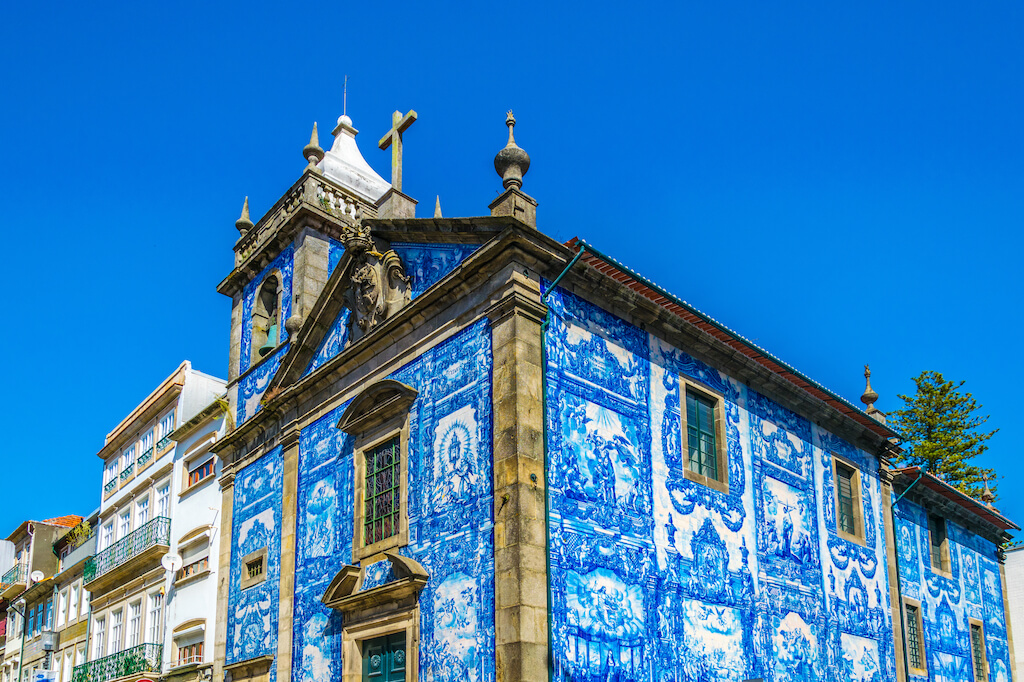
Is the Porto Card worth it?
The answer is: It depends. The Porto Card is a city pass that gives you free admissions to museums, certain discounts, and depending which version you buy, free transportation.
With 3 days in Porto—especially if you’re spending one of them in the Douro Valley wine tasting—you may or may not break even. However, you can buy a single day pass to maximize savings on fees you’d otherwise pay.
It just depends how many cable cars you’re riding and churches you’ll be touring that otherwise require an admission fee. Many sights are free.
Personally, I didn’t buy a Porto Card. We paid few admission fees and walking was convenient. Plus, Ubers are incredibl inexpensive if you’re looking to minimize transport time!
You can check the current price on a Porto card here.
Mercado do Bolhão
It’s just a short block to Mercado do Bolhão from Chapel of Souls. If you’ve read my blog at all, you know that I always make it a point to seek out a lively market when I’m visiting a European city.
Not only is there inevitably fantastic locally sourced food and food products to be enjoyed, but you get to be part of the local shopping experience and feel less like a tourist.
From the Dordogne in France to Barcelona in Spain, this experience is always on my list!
The Mercado do Bolhão in Porto has been welcoming visitors since 1839. You’ll find several floors of farmers, fishmongers, butchers, and fruit sellers hawking whatever is local and in season. Don’t miss the fishmongers who specialize in cod here!
When I visited in June 2019, they were in the process of restoring the commercial space, with a temporary market set up just two minutes away in Fernando Tomás Street. So don’t let that stop you from visiting!
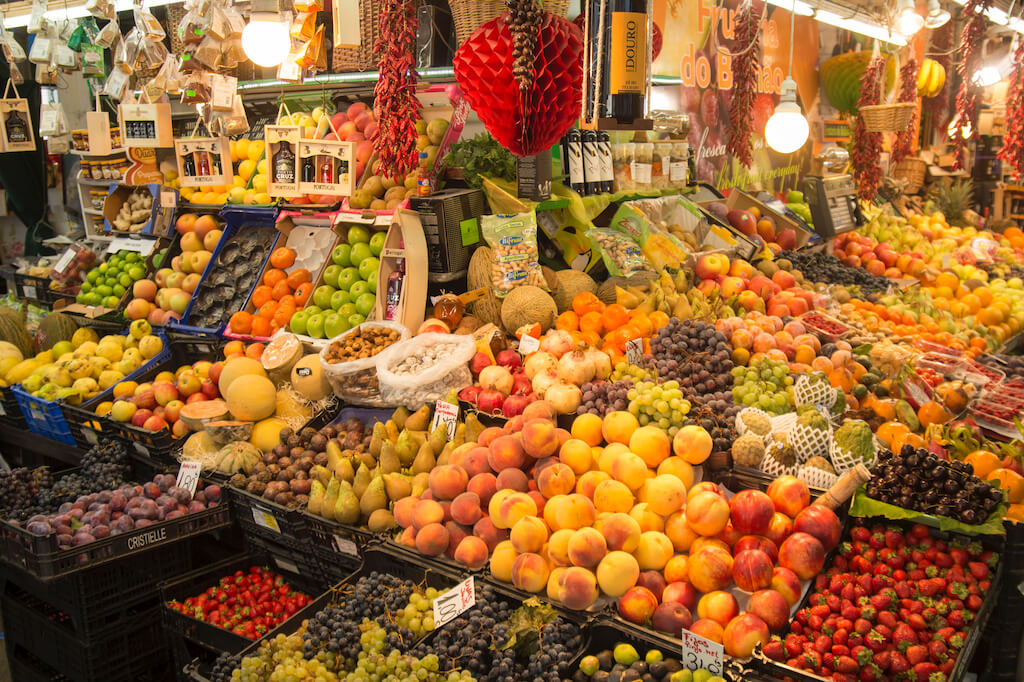
The Church of Saint Ildefonso
It’s hard to miss the 18th century Church of Saint Ildefonso. The tall narrow facade of beautiful blue and white azulejo tilework—almost 11,000 tiles total—almost begs you to stop.
If you’re pressed for time, you can skip the interior of this beautiful little church as there are others with more opulent interior decor on this walking tour.
However, architecture lovers will want to see the retable (the shelf behind the altar) here by the Italian artist Nicolau Nisoni.
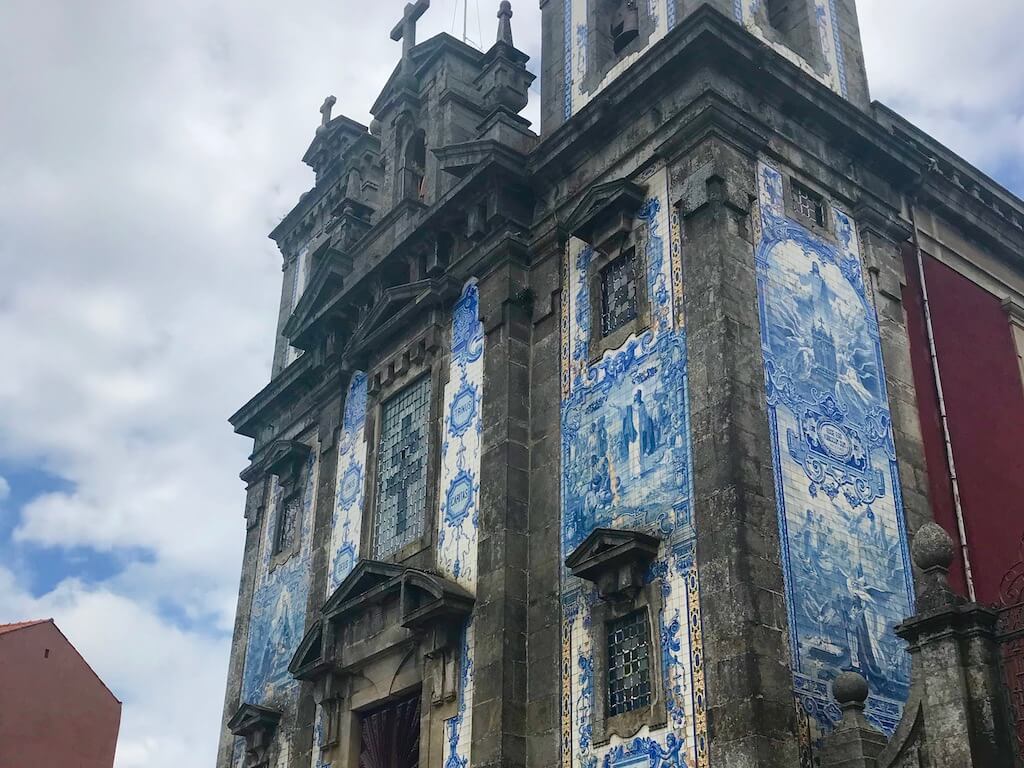
Avenida Dos Aliados
As you head onto Avenida dos Aliados or “Avenue of the Allies,” you are in the very heart of old Porto.
This is a wide, grand promenade lined with stately old hotels. This beautiful boulevard commemorates the 14th-century treaty between the UK and Portugal, which is still honored today.
In fact, it’s the oldest alliance in the world!
At one end, you’ll spy the bell tower of the old town hall. At the other is Praca da Liberdade, a beautiful square. At the center of that square, you’ll find a bronze equestrian statue of King Pedro.
There are some cafés in this area, but keep walking towards the Clerigos bell tower!
Clérigos Church and the Bell Tower
Spend some time here! This is one of Porto’s most famous monuments.
The Clérigos Church (or “Church of the Clergyman) is an absolutely incredible Baroque church. Construction began in 1732 and finished eight years later.
On the facade, you’ll spy lots of Baroque symbols…like shells and garlands. The inside of it is simply awash in gold.
But the most famous feature is the iconic bell tower. Inspired by bell towers in Tuscany, this tower can be spied from most spots in the city.
If you climb its 200 plus steps, you’ll be rewarded with a phenomenal bird’s eye view of Old Town and the Douro River. There are 49 bells up there at the top!
It’s free to enter the church but costs 3€ to climb the tower. Hours: 9 to 7 am daily. You can buy an online admission ticket here.
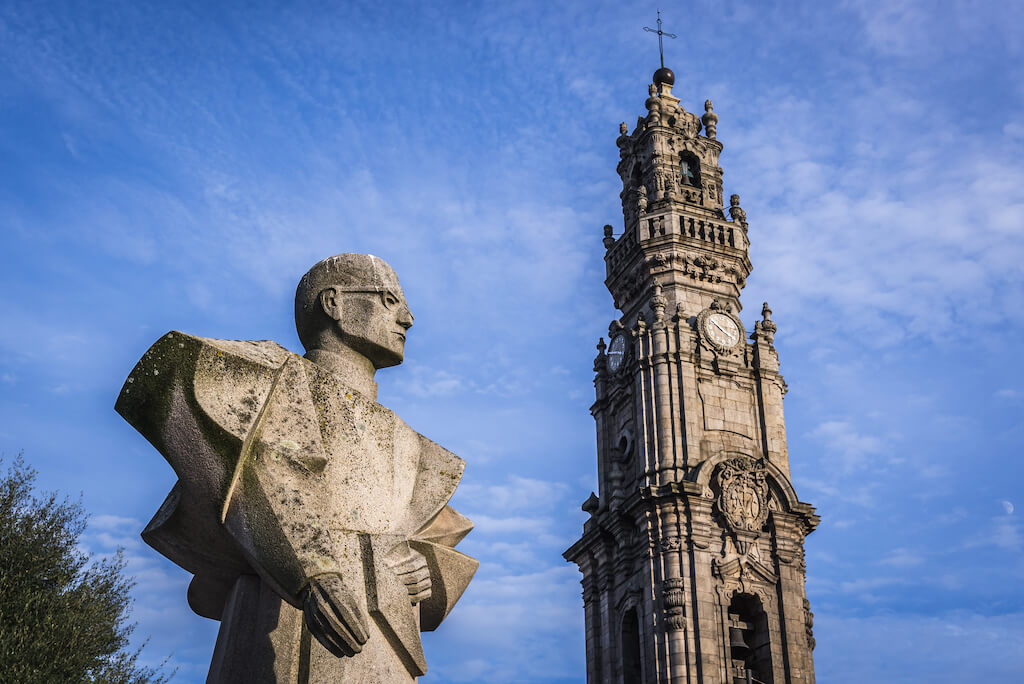
Livraria Lello: Yes or No?
The Lello bookstore is a unique and beautiful bookstore—perhaps Porto’s most famous sight these days—made so by JK Rowling who allegedly used it as inspiration for Hogwarts in Harry Potter.
After all, she worked on the books while she taught English in Porto.
There is no question that Livraria Lello, also one of the world’s oldest bookstores—hosting Portuguese intellectuals since 1906—is architecturally stunning.
It’s a tiny jewel box of a boutique with a dramatic red staircase that ascends to the second floor.
All of that said, I’d urge you to skip it. What?!
Here’s the problem: Before Lello became so famous, there used to be lines in Porto to climb the famous bell tower…which makes sense. If there must be lines somewhere, that view is worth it!
Now, however, no one waits to climb the tower (good news for you!); instead, the lines are all about getting into the bookstore.
But the place is tiny and no matter what time of day you go, you will likely feel claustrophobic from the crowds as you strain like a salmon swimming upstream to access the second floor…only to come back down and exit. Because too many people!

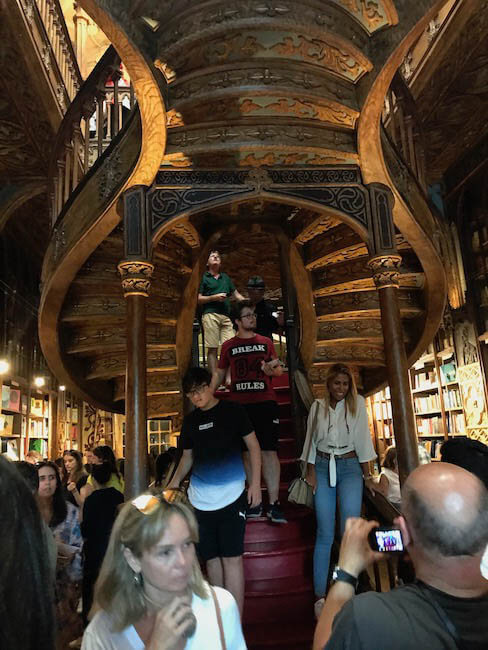
Read more on Portugal and Spain travel:
• Best Lisbon day trips
• 16 Cities to see in Spain
• Activities to do in Seville
• 14 day Spain itinerary
If you really want to go: If you’re a die-hard Harry Potter fan and you’re dead set on going despite my warnings, here are my best tips:
First of all, pick a time and buy your ticket online. Otherwise, you will have two lines to brave at the bookstore.
First, you’ll go into the building next to the bookstore, head downstairs, and then stand in a long line to buy a ticket. Next, you’ll need to lock any backpacks or packages in a locker there. (You can enter with a purse, however.)
Then you’ll head back out onto the street where you will wait in a second line to show your ticket to get in.
So, you’ll need to organize your whole day around the time you selected in advance. Or wait in the two lines at the shop.
Internet was not great outside the store so I was ultimately unsuccessful when I tried to skip the line by purchasing a ticket online right before entering.
My other tip is to plan your visit to Lello during a weekday (versus a weekend) and be in line when they open at 9:30 am or right before closing at 8 pm. But expect lines and crowds then also!
See what I mean? Climb the bell tower instead!
The Twin Churches: Igreja Carmo & Igreja Carmelitas
You’ll spy these two churches side by side—the Carmo Church and the Carmelite Church—on the corner of Carlos Alberto Square and Rua do Carmo, near the Clérigos Tower.
How will you recognize them? By the huge blue and white tiled facade on the side of Carmo, of course!
Carmelitas is the smaller of the two churches, part of a 17th-century convent with a bell tower. The larger church, Carmo is a 19th century Baroque masterpiece.
And sandwiched just between these two churches is a very narrow house designed to keep the monks and nuns from having any contact with each other.
You can tour inside if you like, but you’re mainly here to admire the tilework. Keep walking!
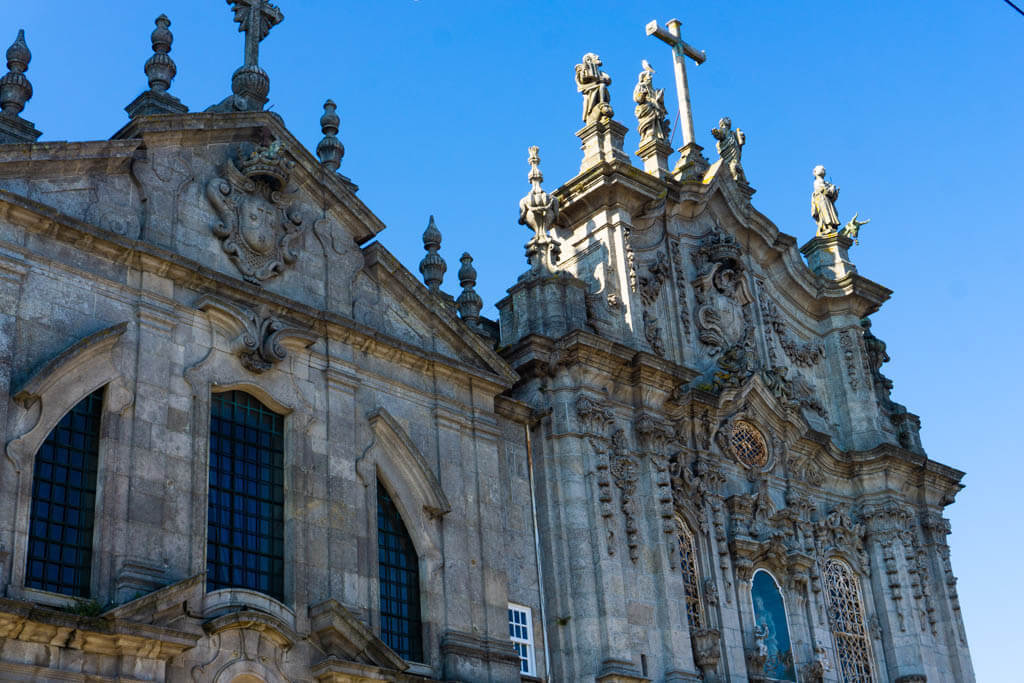
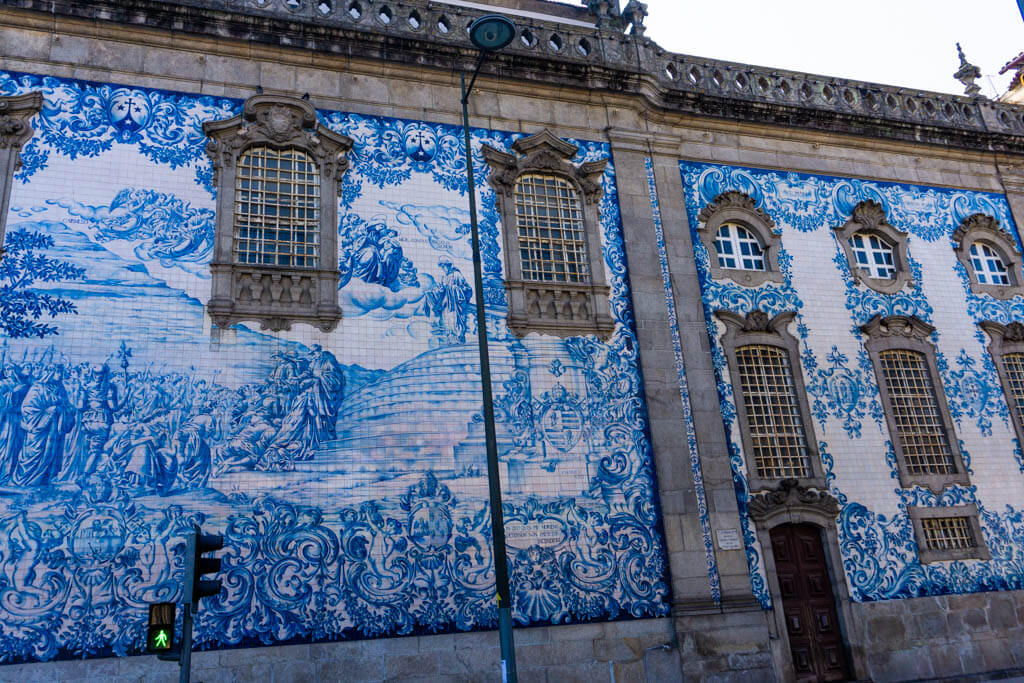
Praça do Lisboa
Whether you’ve climbed the tower or braved Lello—either way—you’ve earned a rest! Praça do Lisboa, a lovely urban park is the perfect spot to do it.
The park is an innovative three-level affair, with the uppermost level planted as a grassy rooftop with olive trees, in a nod to the “Porto do Olival,” the former gateway to the city.
The middle level is for commercial use while the ground level is for parking.
It’s a creative public space that works. In fact, on summer evenings, you’re likely to find lots of locals sharing a drink and a conversation on the inviting green here so join the party!
Church of São Francisco
Along with the earlier mentioned Clérigos Church, the Church of São Francisco is worth time to explore the interior. Think intricate wood carvings and gold leaf everywhere.
This Gothic church was established by the Franciscans in 1244 and expanded into the 14th century.
Don’t miss the incredible Tree of Jessee altarpiece, an intricate wood carving. The rich decorative gilt woodwork here is considered among the best in all of Portugal.
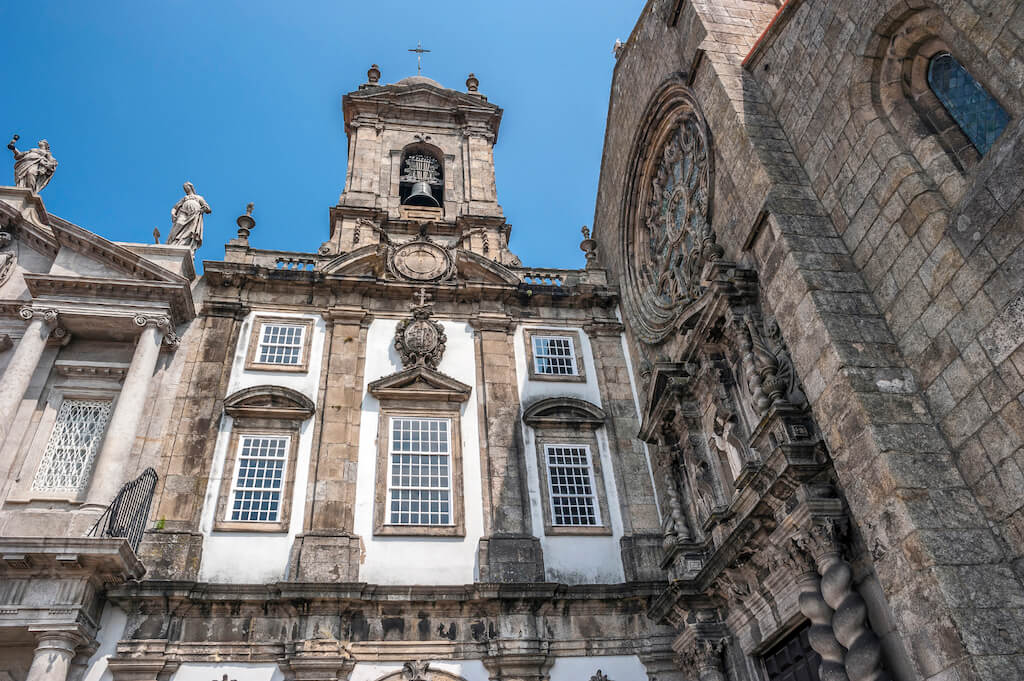
Take the #1 Tram
Ready for a break from walking? Consider a scenic 20-minute ride on one of Porto’s antique cable cars along the Douro River.
If you skipped the cable cars in Lisbon due to the sheer crowds of people waiting to catch one, now’s your chance to rattle along in this quaint car.
You can conveniently catch the #1 tram just outside the Church of São Francisco.
It can be a little confusing if you’re new to this experience so here’s what you need to know. Tram “Linha 1” extends to the Passeio Alegre Park in the Foz District.
It can be busy, which could mean being sandwiched among other tourists standing.
You’ll want to avoid that so that you can see out the windows. (Sit on the left side for a river view.) This route is not available as a “loop.”
So you’ll need to buy two tram tickets for €6 total from the conductor as you board. Then, he will ask everyone to disembark at the end of the line before you re-board for the trip back. Bring cash.
If there’s a line when you arrive, just wait for the next tram for better seating as they run frequently. Better yet, plan to catch the tram early or late in the day for fewer crowds.
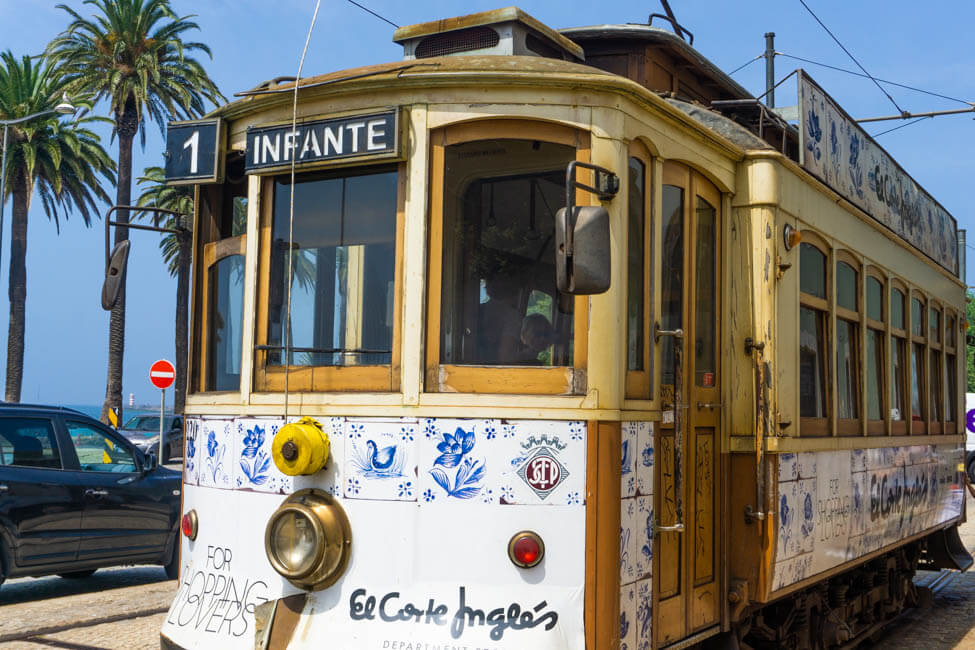
Fado Performance
Fado is Portugal’s answer to Spain’s flamenco music and hearing a performance is one of the most romantic things to do in Porto. While flamenco can be impassioned and staccato, fado music is mournful and yearning. It’s the soul of Portugal.
Fado hails from Lisbon, but when we were there, we found it difficult during our limited time there to locate a venue that didn’t involve committing to an entire evening that included an expensive dinner as well.
If you have more time, consider fado in Lisbon. Otherwise, plan on seeing an hour-long acoustic performance here in Porto at Casa ds Guitarra as we did.
It’s an intimate space conveniently located near the riverfront. It features a female singer and includes a glass of port.
You can reserve a fado performance here. (Free cancellation up to 24 hours before the performance.)
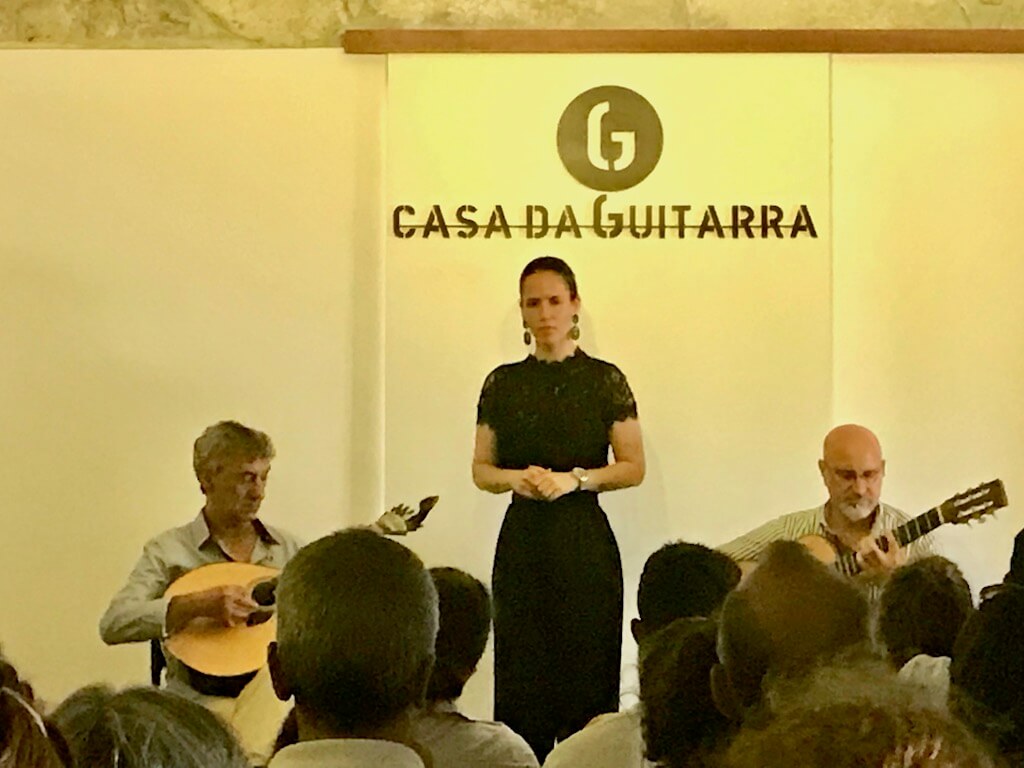
Where to Eat on Day 1
Each of the recommendations below is conveniently located along the Day 1 walking tour above.
While in Porto, carnivores need to try the specialty “hot dog” here. Ask for a “cachorro” or just point at what everyone else is having at Gazela, the snack spot that locals love best. It’s also one of Anthony Bourdain’s favorite Porto restaurants.
In fact, there’s a new trend in Porto where locals move from bar to bar sampling snacks…much like the Spanish do for tapas. This is delicious (and heavy) street food…essentially a gourmet hot dog with cheese.

Try the ice cream at Santini Gelato or consider a drink in the garden at Hostel Selma. Comme Ça offers a great deal on a prix fixe Portuguese meal. A Sandeira is a great hole in the wall spot for a sandwich.
You can enjoy a snack, drink or meal any time of day at beautiful Majestic Café, rated one of the ten most beautiful cafés in the world.
Just be aware that there are no reservations and lines out the door at every time of day.
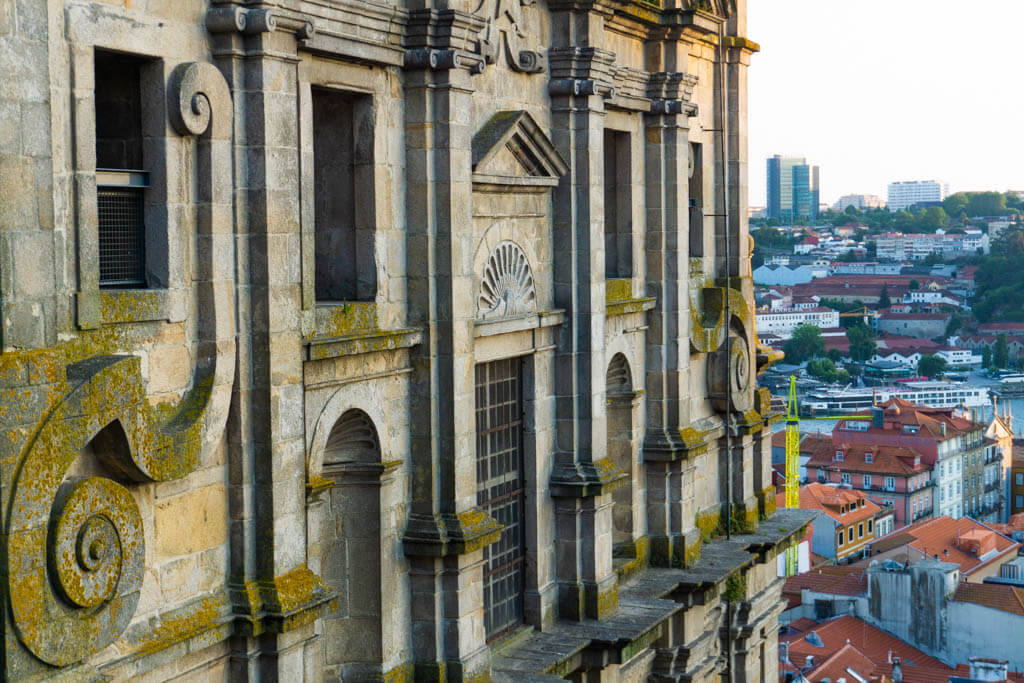
Day 2: Vila Nova da Gaia
Yesterday you saw the Best of Porto’s Old Town and famous Ribeira neighborhood. Today, you’ll head across the Douro River to Gaia, home to all the best Port houses for tasting. Welcome to Day 2 on the best Porto itinerary!
But before you cross the river, see:
São Bento Train Station
I think that the incredible São Bento Train Station was my favorite—and most surprising— sight in Porto. Do not miss this stunning sight while you’re here. This is one of the best things to see in Porto!
Located in the heart of Porto, this incredible Baux-Art building is literally wall-to-wall tile…20,000 glazed ajuelo ceramic tiles in fact. The train station was built in the 26th century, destroyed by fire in the 18th century, and then rebuilt.
In addition to the traditional blue and white tile you’ve admired elsewhere, a large swath of tile that circles the ceiling tells the history of transportation in Portugal in all its full-color gory.
You’ll also find a full wall devoted to the 12th century Battle of Valdavez and the 15th century Conquest of Ceuta.
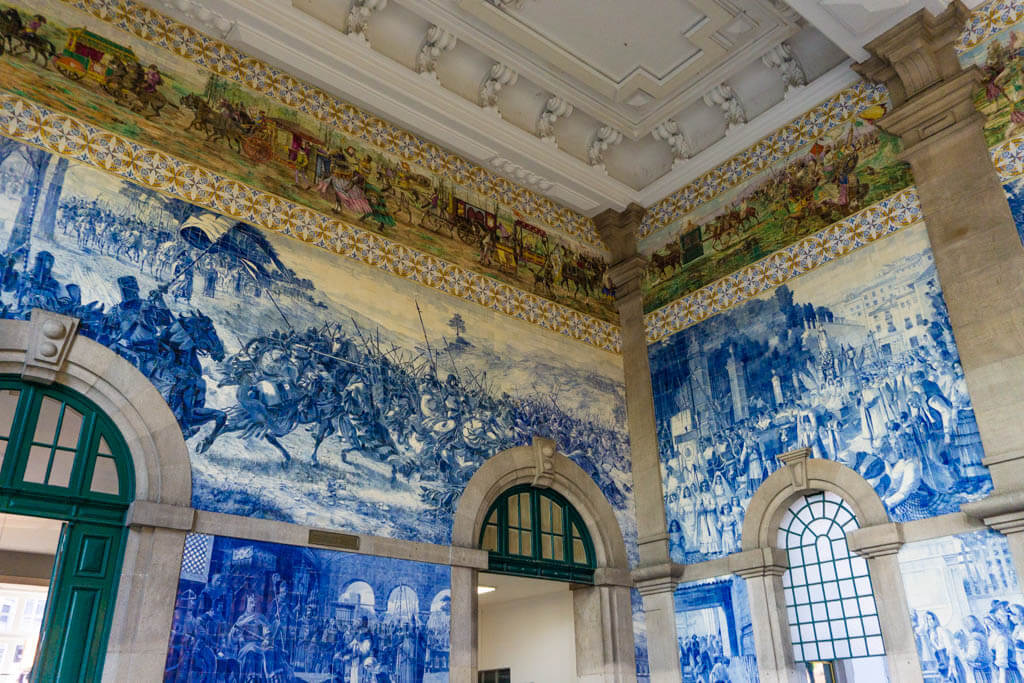
Porto Cathedral
You may have mistaken this beautiful cathedral for a castle and it’s easy to understand why. Yet, there are no castles at all in Porto!
Located at the highest point in the city, just before you cross the Dom Luis Bridge into Gaia, Porto Cathedral was originally built in the 12th century, with numerous later renovations.
It’s mostly Baroque but a bit of an amalgamation—with a Romanesque nave and Gothic chapels, for example—due to all of the renovations.
This is a great spot for photos and sweeping views of the city. Entrance to the cathedral is free, although entrance to the cloister is 3€.
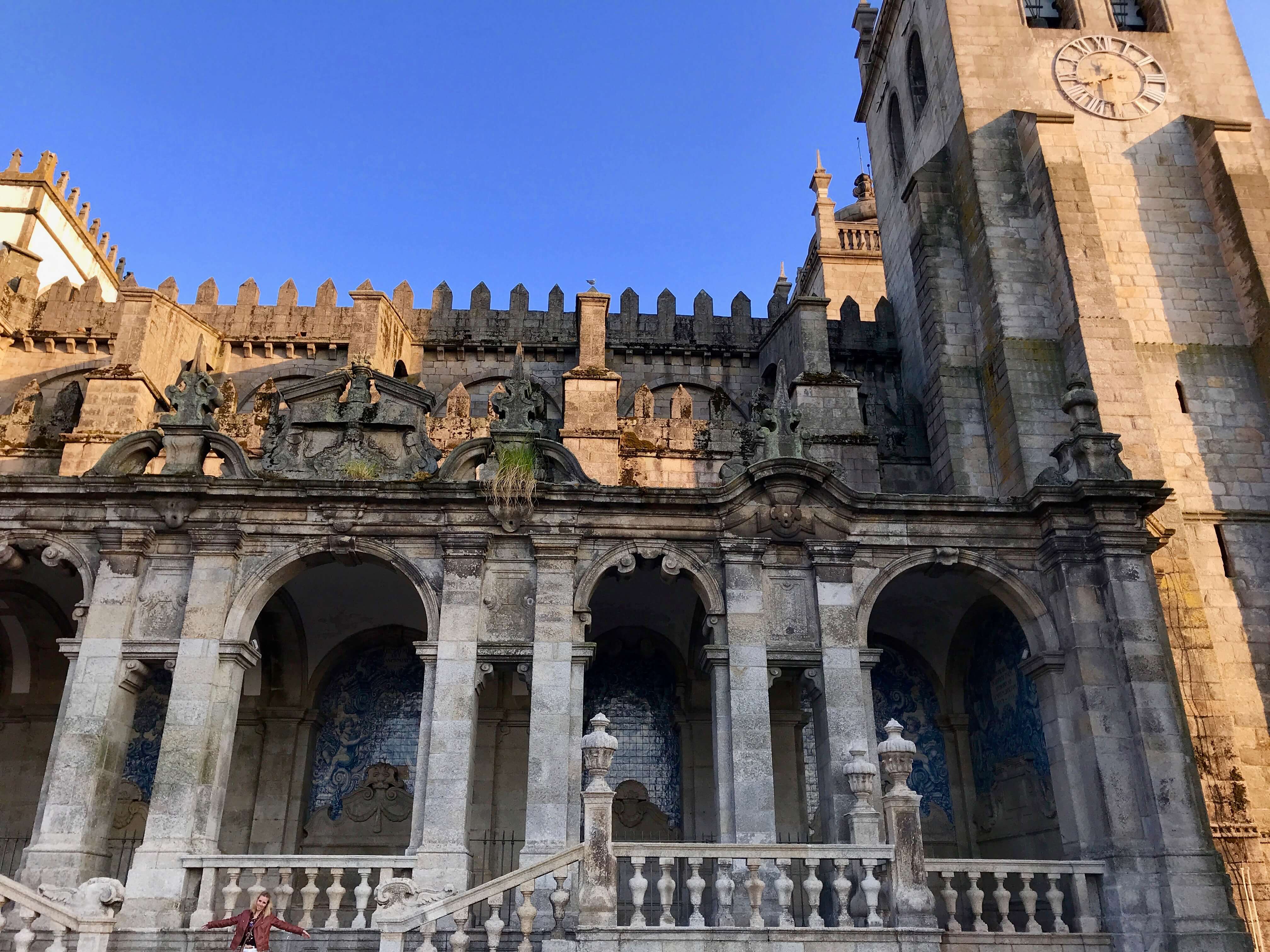
Also, consider taking 30 minutes to wander the beautiful (and steep!) cobbled streets towards the river here.
Years ago—before Portugal decriminalized drug use—this area was full of addicts looking for their next fix.
Today, it’s full of proud homeowners of new apartment with plants spilling from their windows and lovely secret cafés around every bend.
(Sidenote: Portugal’s radical new drug policy is working and countries around the world could learn from it.
Homelessness, incarceration rates, overdoses, and HIV infections are all dramatically improved. Read more here from the Guardian.)
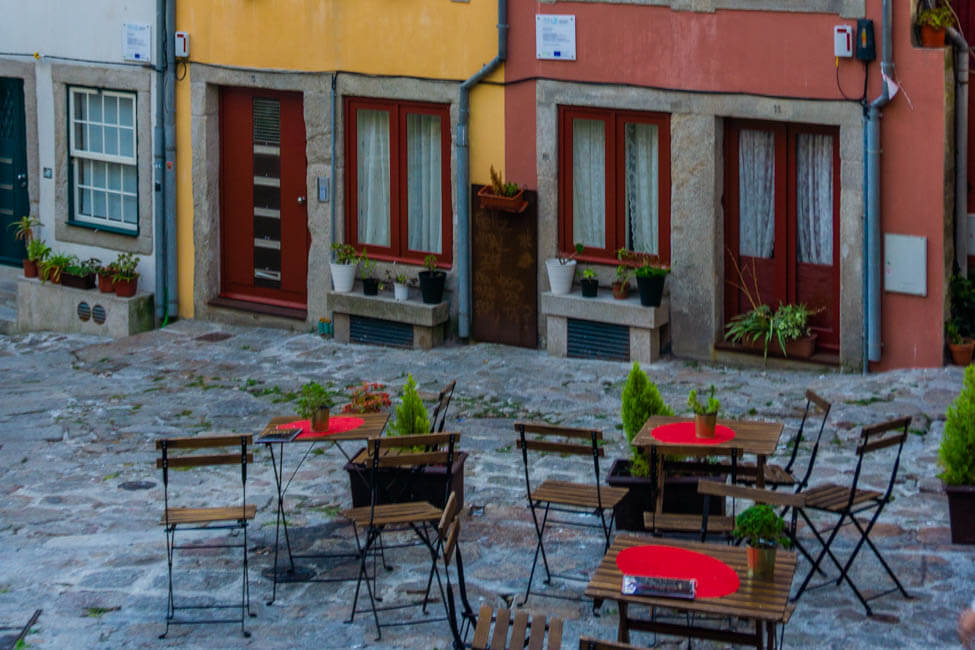
A warning: If you wander down the steep alleys past the Porto Cathedral, you’ll, unfortunately, have to climb back up to cross the bridge to Gaia unless you take the handy Funicular dos Guindais.
You can catch the funicular at the base of the Dom Luís Bridge for a quick ride to the top of the hill there. It’s not a “must-do” in Porto but it will save your feet for just a few euro!
Dom Luís I Bridge
There are six bridges in Porto that span the Douro River!
The double-decker Dom Luís I Bridge, a UNESCO World Heritage Site located just past the Porto Cathedral, was the longest bridge of its kind anywhere when it was constructed by Gustave Eiffel—of Eiffel Tower fame—back in the late 19th century.
It’s one of Portugal’s most famous landmarks.
That’s why the iron arches of this bridge and its sister bridge, Dona Maria Pia bridge, are so reminiscent of the Eiffel Tower.
Walking from Old Town, you’ll cross by foot on the upper level; it’s designed for pedestrian and train traffic while the lower level is reserved for cars.
Teleferico de Gaia Gondola
Once you’ve crossed the Luis I Bridge, you can either walk down to the riverfront, or catch the Teleferico de Gaia.
It’s just a five-minute ride to zip down and it’s not cheap at 6 € one way (or 9 € to include a return trip), but it does cut down on all the walking!
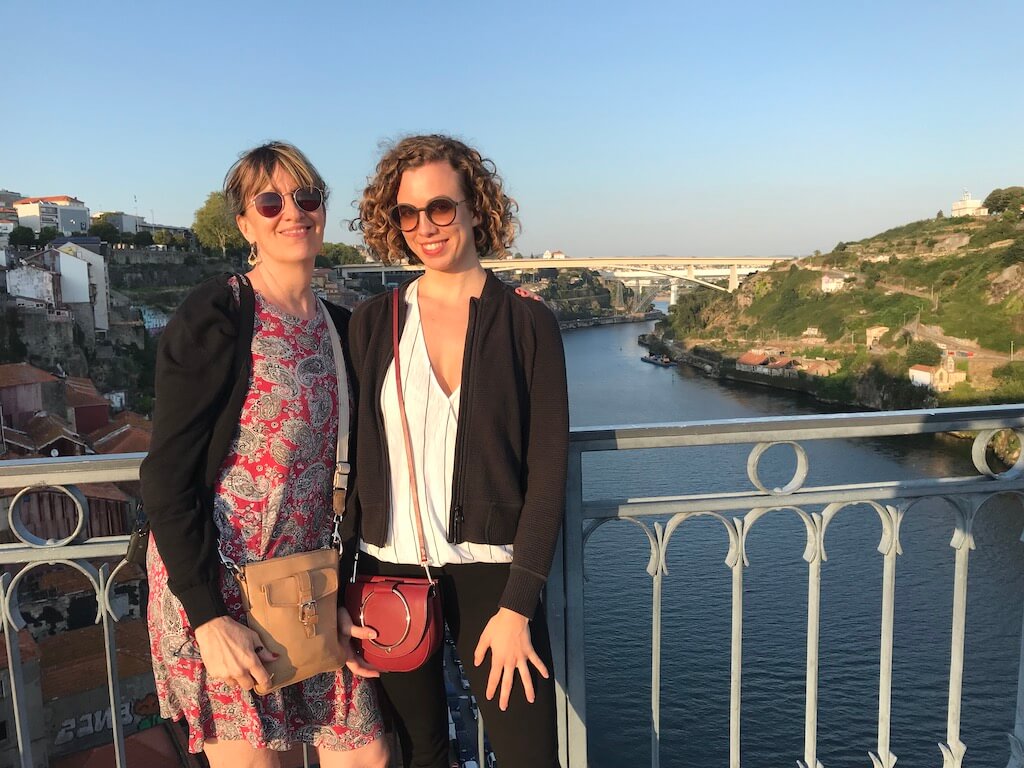
Stroll the Riverfront
Once you’ve crossed over the bridge into Vila Nova de Gaia, spend 10 or 15 minutes looking back across the river into Ribeira and admiring the beautiful Rabelo boats docked here.
These traditional Portugues boats—adapted from Viking boats—have been used as cargo boats for hundreds of years to carry barrels of Port from the Douro Valley to the wine cellars in Gaia here in Porto.
Today, you can book a day cruise along the river. If you’re planning to head into the Douro Valley for wine tasting (see Day 3 below), I recommend you wait for your river cruise there.
If not, book a 50-minute river cruise to sail under the six bridges of the River Douro for Day 2. You can check prices and availability here.
Taste Some Port
What would a visit to Porto be without tasting some of the most beautiful dessert wine on the planet?
Port cannot be called Port legally unless the grapes have been grown in the nearby Douro Valley here. You’ll find tawny Port, white Port, and ruby Port for sampling here.
Famous port houses line the riverfront here so you’ll have your choice of tastings. Be sure to book a reservation for a tour and tasting. (But don’t wait until evening for this activity. They’ll all be closed then!)
Traveler favorites for port tasting in Porto include Grahams, Sandeman, and Taylor’s Port.
We had no problem booking a same-day tour and tasting at Taylor’s and loved sipping our Port with a cheese plate in the beautiful garden there. You can get tasting and tour tickets at Taylor here.
If you don’t have time to head into the Douro Valley, consider a more immersive experience here in Gaia.
For example, how about an interactive guided tour and tasting paired with chocolate and cheese? Yum! Check out prices for the Cálem Cellars guided tour here.
Catch the Sunset
As the light wanes on your beautiful day in Porto, head to Miradouro das Virtudes. “Miradouro” means viewpoint and Portugal is famous for them!
Miradouro das Virtudes is a local favorite for sipping a glass of wine at sunset. As you watch the sun set over the Douro River, you’ll definitely think about extending your stay in this magical fishing village!
Where to eat on Day 2
One of my goals while in Portugal was to understand the country’s fascination with salted codfish. It’s piled high in grocery stores and on every menu!
So I asked locals for recommendations on where to taste Bachalau á Brás, a famous dish of potatoes, scrambled eggs, and codfish pieces.
They sent me to Restaurante Bacalhoeiro, located in Gaia just along the river and it did not disappoint. (Although I also heard good things about O Afonso across the river.)
Served with some light and sparkly Vinho Verde (green wine) as the sun set over the River Douro was memorable indeed. Reserve ahead!
Day 3: Duoro Valley Wine Tour
Does it really make sense to devote a whole day to a wine tour in the Douro Valley when you only have a 3 day trip to Porto? Yes! It’s gorgeous. Just look at it…
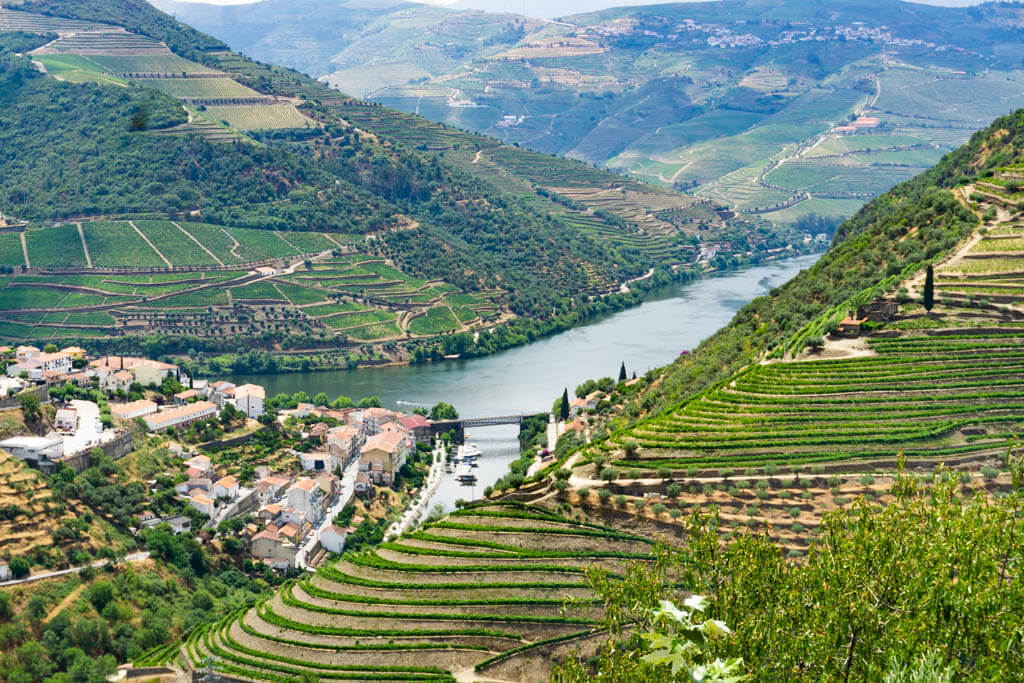
In fact, the Douro Valley is such a unique and beautiful landscape that I’d even recommend non-drinkers tag along on a tour.
If you are a wine lover with more than 3 days in Porto, consider overnighting with a car for an extra day or two in this beautiful valley for more time. Really think about how to plan your wine trip.
But only in spring or fall—the fall foliage is fabulous—as it can be pretty warm here mid-summer! The Douro Valley is one of the best places to visit in Autumn during the wine harvest.
Our day tour to Douro Valley was one of the most memorable days of my few weeks in Portugal.
We joined six other people in Porto (hotel pick-ups can be arranged) for an air-conditioned hour-long ride to the valley in a small van, stopping at incredible viewpoints en route.
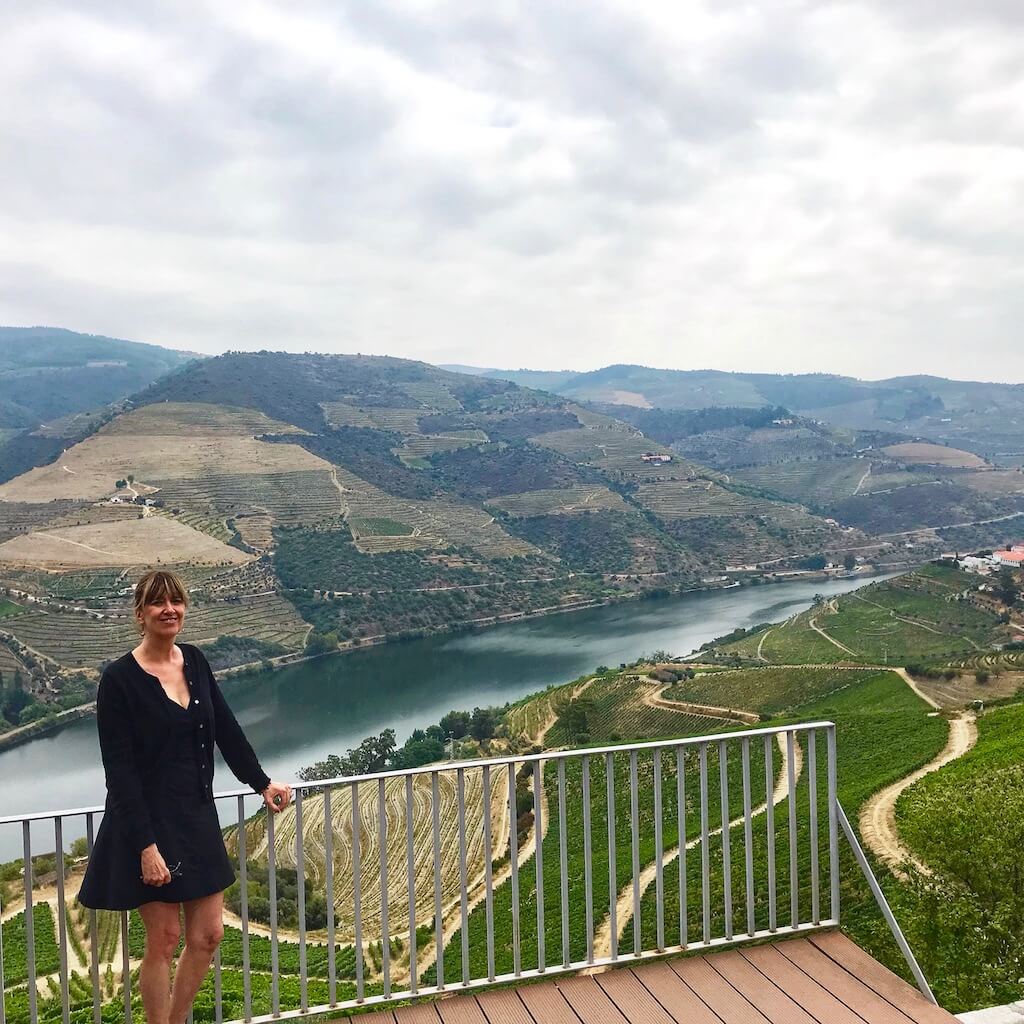
About the Douro Valley
The terraced vineyards here are striking. Rows of olive trees create natural fences and boundaries between the many “quinta”—wine-producing estate—that run throughout the 60,000 acres of valley.
Rose bushes nestle up against grape vines frequently here, acting as a “canary in the coal mine” to alert winemakers about when to treat for mildew.
Here, fathers pass down a grafting tradition for the grapevines to their sons. In the 19th century, an imported bug caused a blight on grapevines across Europe, killing 90 percent of the vines.
In France, winemakers ripped out their vines at the time and replaced them with imported American vines immune to the pest, only to find that the grapes were bitter and undesirable.
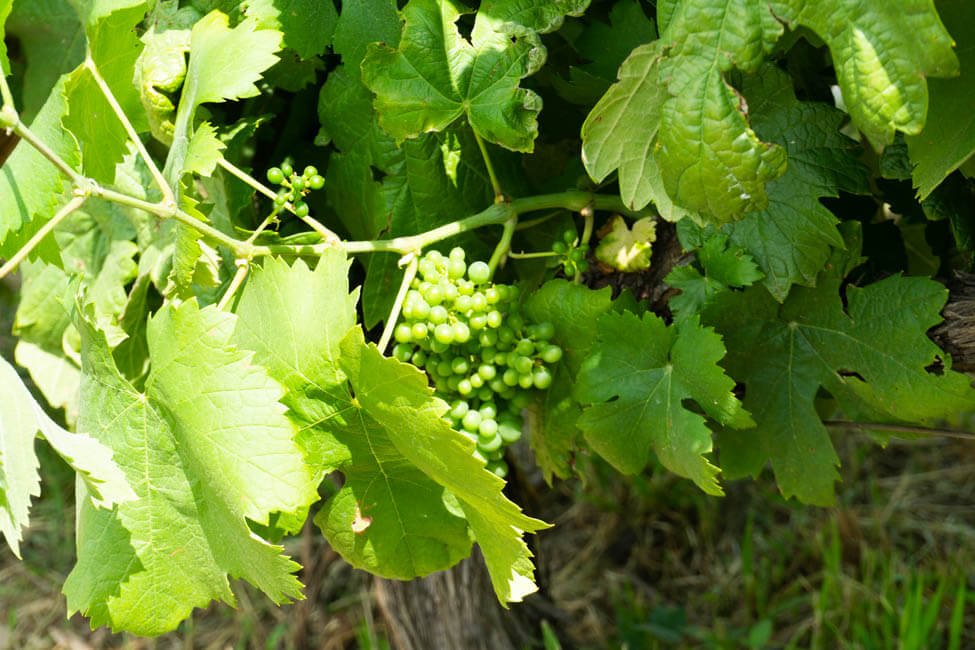
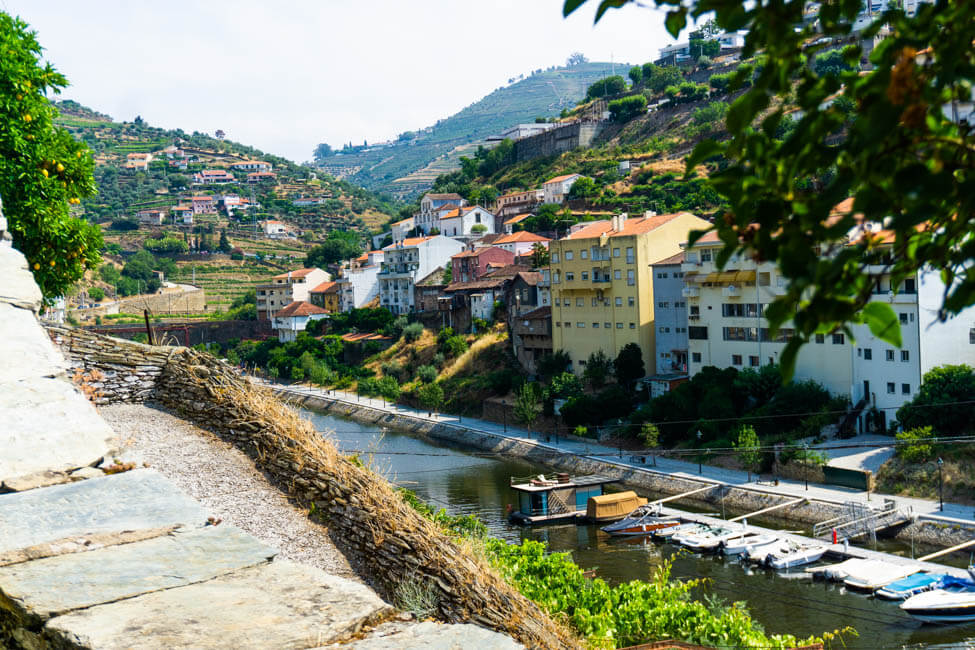
And then, Duoro Valley winemakers devised a technique for grafting the immune American vines onto their own vines for a stellar success…a technique adopted around Europe and still used in the Duoro Valley and elsewhere today.
From harvesting to blending, every aspect of winemaking is still lovingly done by hand in the Douro Valley.
In fact, at our first stop for tasting at the tiny, family-owned Quinta da Foz Winery, I watched a woman meticulously labeling each bottle for sale.
Wine Tasting and Cruising the Douro River
After tasting three wines at Quinta da Foz, we enjoyed a lovely private lunch in the living room of a prominent local family of winemakers whose roots run deep here.
Our lovely lunch was cooked by the lady of the house and served by her son. Some delicious wine and port pairings—followed by a tour—finished out the meal.
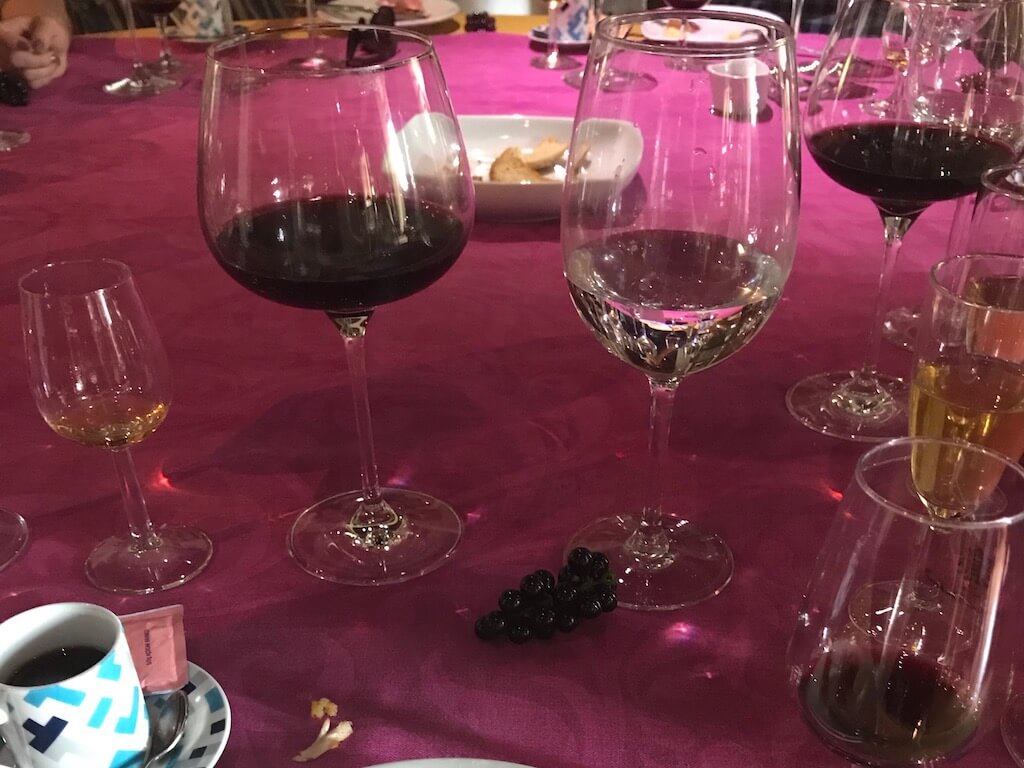
Imagine our surprise after such an expansive lunch to arrive on the boat for our Douro Valley River tour here only to find appetizers and cocktails!
It was a singular experience to gaze up at the quintas and terraced hillsides while cruising the river…imagining the deft seamen that once navigated heavy barrels of Port on rocking boats on a wild river (before there was lock) in days gone by.
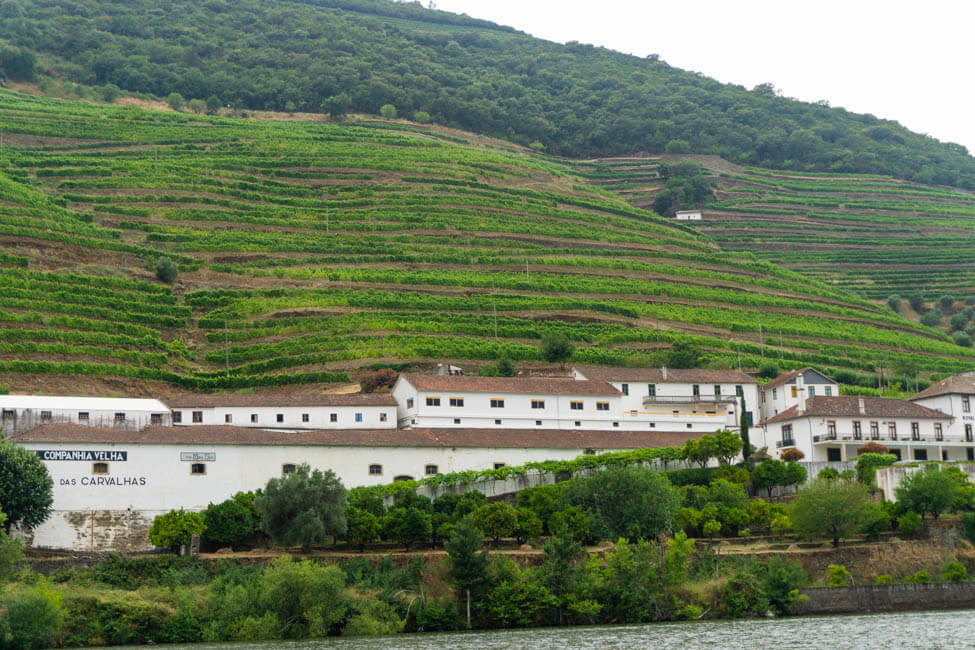

All in all, I can’t recommend this Douro Valley tour highly enough. Comfortable transportation, a friendly, accommodating guide, and a truly local experience tasting, cruising, and lunching in the lesser-known spots.
There are many, many Douro Valley tours available. But if you’d like a personal, intimate experience rather than being herded with throngs of other tourists, choose this one! I can vouch for it personally.
You can check for prices and availability on my recommended Douro Valley tour here.
Where to Eat on Day 3
You’ll return from your Douro Valley tour to Porto in plenty of time for dinner!
If you need a break from traditional Portuguese food (or even if you don’t), I highly recommend the gorgeous, healthy fare at Tapabento (but you’ll need to reserve several days ahead to get in) or Viva Creative Kitchen.
We also enjoyed the incredible Asian fusion cuisine, unique cocktails, and ambiance at Boa Bao Asian so much that went twice during our week in Porto!

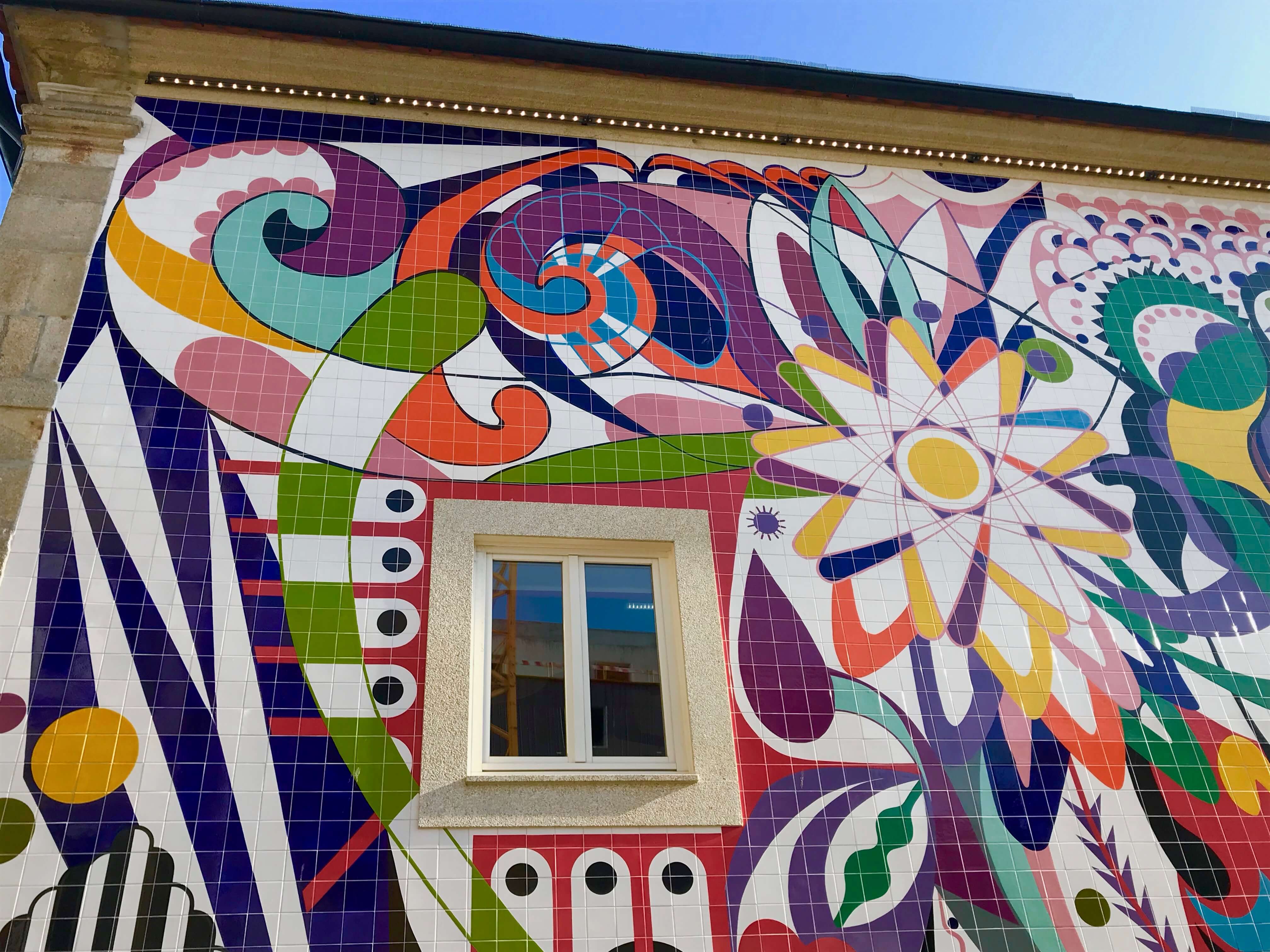
Only 2 Days in Porto?
With just 48 hours in Porto, use my Day 1 walking tour of Old Town and Ribeira, spend your second day in Gaia as above, and save the Douro Valley for a next trip.
FAQ on Visiting Porto
1. Is 3 days in Porto enough?
Yes! We think three days is the perfect amount of time to visit Porto. A three day itinerary leaves just enough time for a walking tour to see the main sites, explore the best Port houses in Nova de Gaia, see a Fado show, and still reserve a full day for wine tasting in the Douro Valley.
With more time—we spent a week here—you’ll want to use Porto as a base to enjoy some great day trips.
A few ideas: Braga in northern Portugal is known for its beautiful countryside, vineyards, and delicious food.
Santiago de Compostela is a UNESCO world heritage site just over the border in Spain. It’s a famous pilgrimage site and the Old Town here is incredibly beautiful with its Romanesque, Gothic, and Baroque buildings.
2. Is Porto a walkable city?
Double yes! It’s compact and easy to get around by foot. While not as steep as Lisbon, you will be heading down a steep incline to sites near the river and back up again so just keep that in mind as it’s easy to lose uphill walking motivation after too much port tasting (haha).
3. What’s the best way to get around Porto?
For Porto travel, it’s super convenient and inexpensive to grab an Uber. Public buses run here, too.But don’t miss out on riding one of the cute antique trams!
They’ve been around since 1895! They’re mostly used by tourists rather than locals today but it’s an experience you don’t want to miss here. Cost is 3,50€ per person.
4. When is the best time to visit Porto?
To miss the summer tourist crowds, time your visit to Porto in spring or fall. The weather is still beautiful and warm but not hot and accommodation prices are lower.
Autumn—September and October—can be particularly lovely with some beautiful autumn foliage. Plus, it’s harvest season in the Douro Valley!
5. Where are the best viewpoints in Porto?
Portugal’s “miradouros”—or viewpoints—are world-famous so be sure to visit some while you’re in Porto. Top viewpoints are: Porto Cathedral on Terreiro da Se street, Miradouro da Serra do Pilar, Marginal de Gaia, Miradouro da Vitória, and Clérigos Tower.
Like this post? Pin it for later!
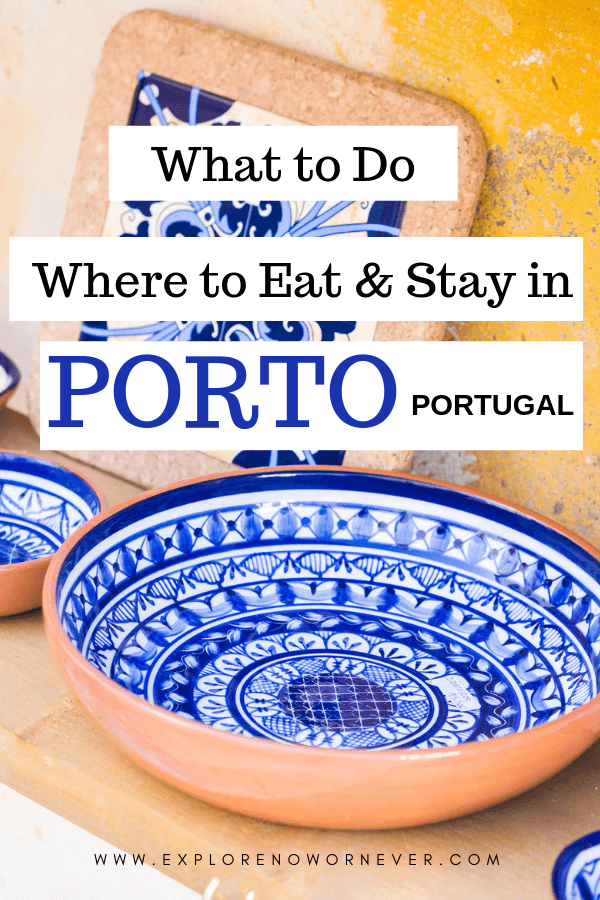
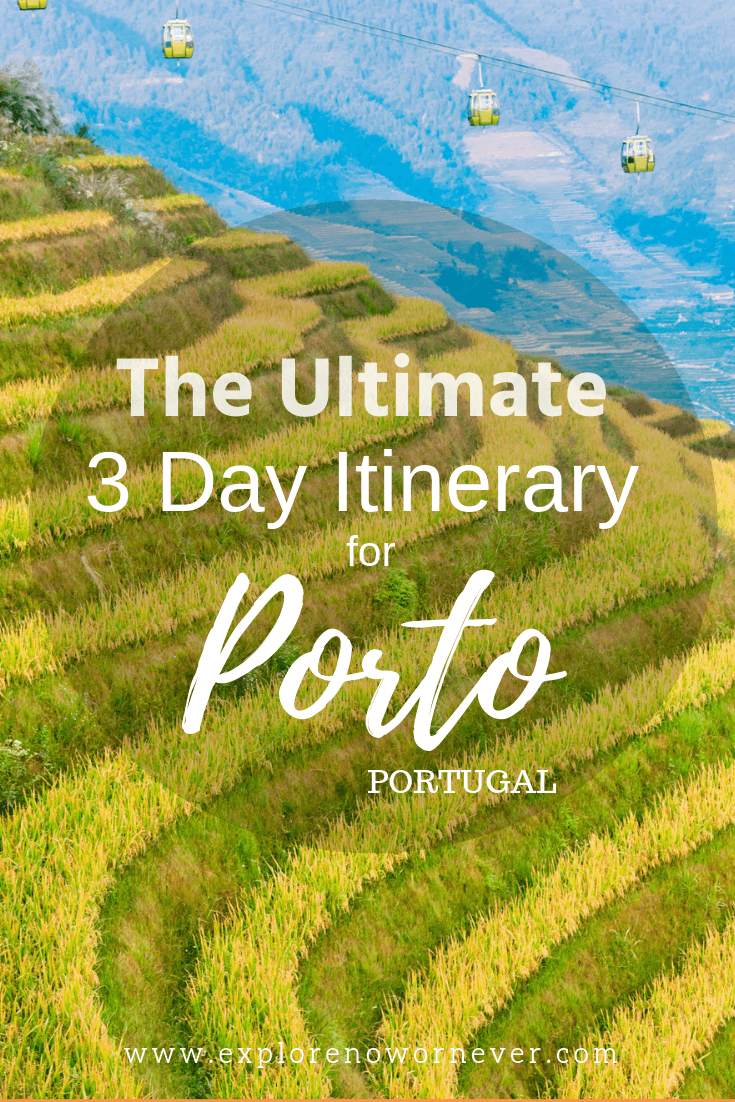
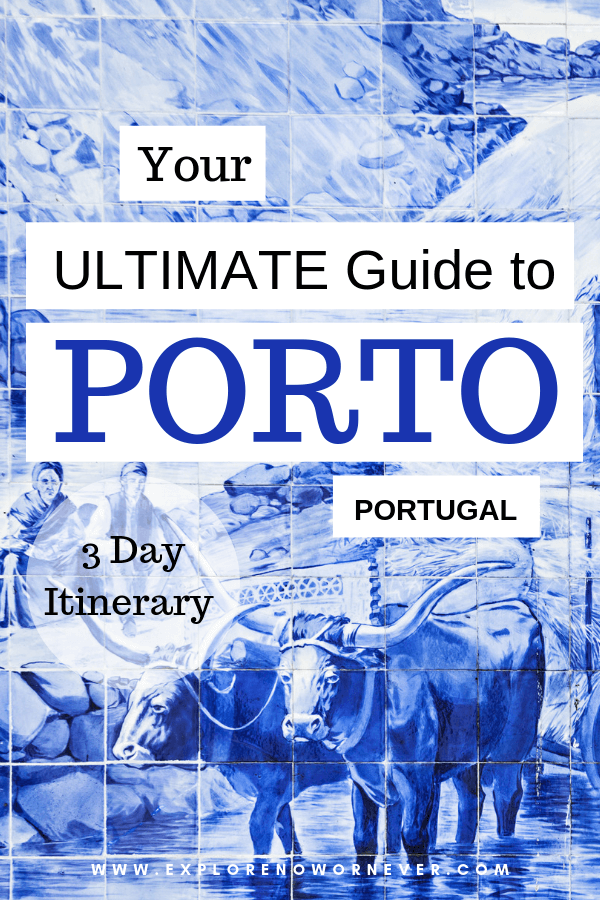
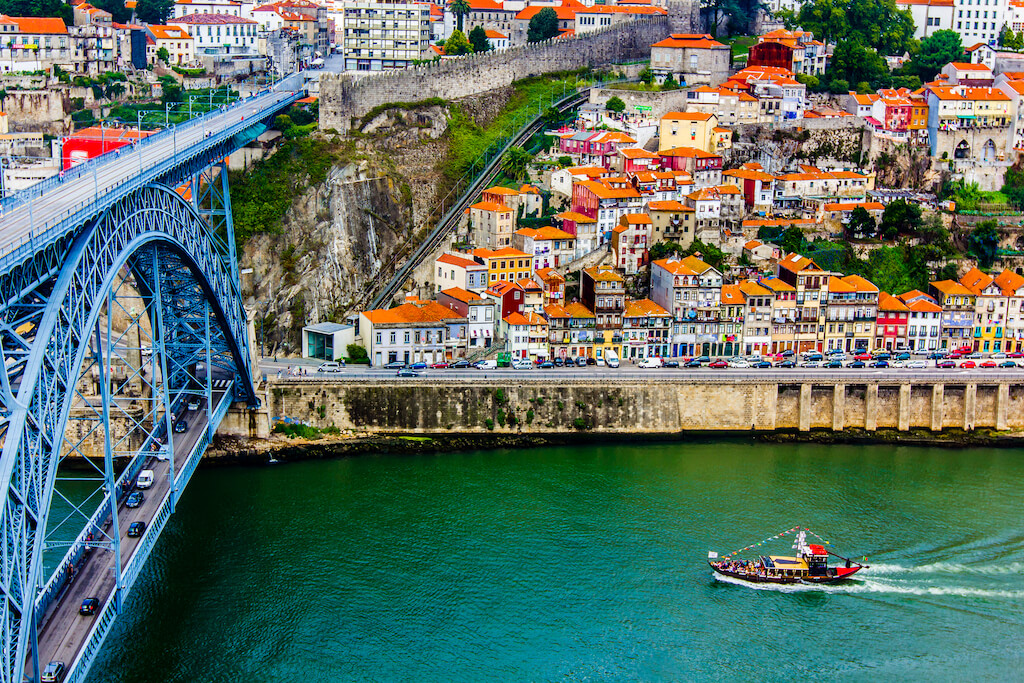
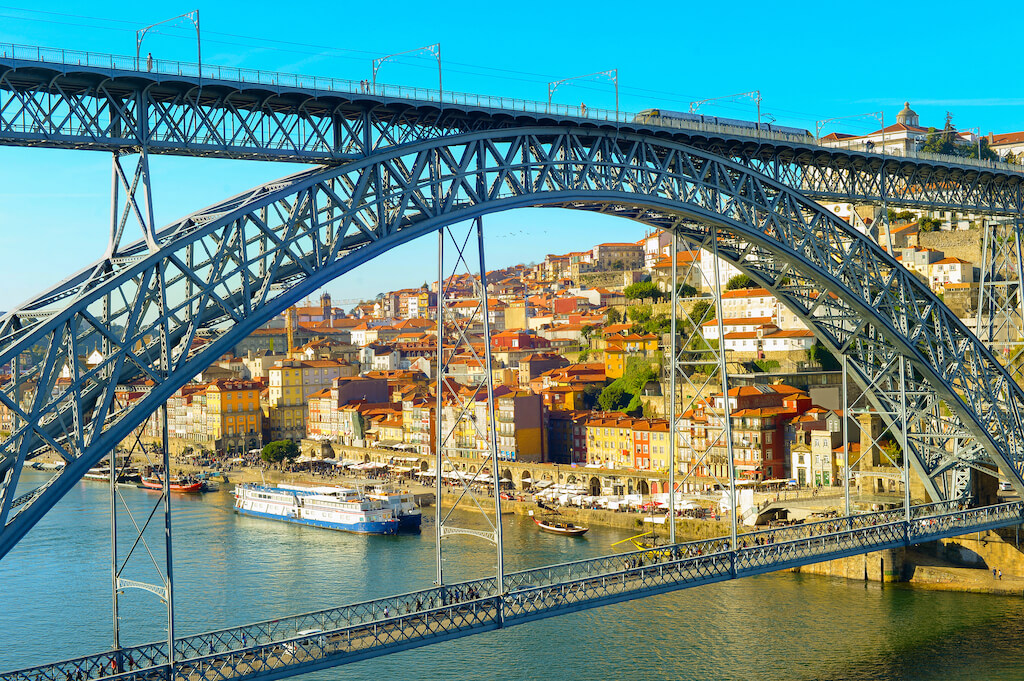
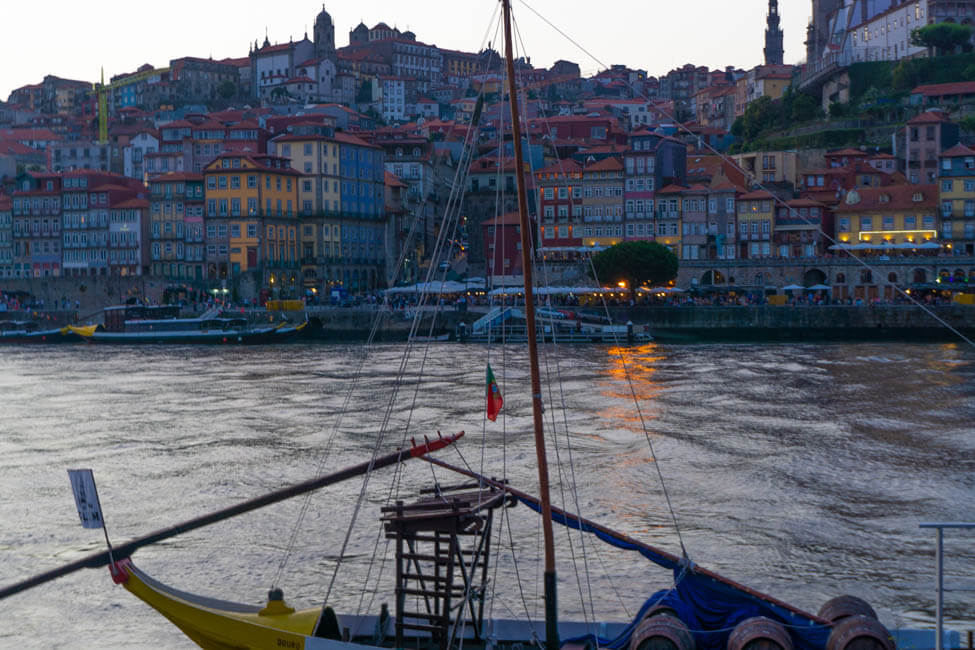
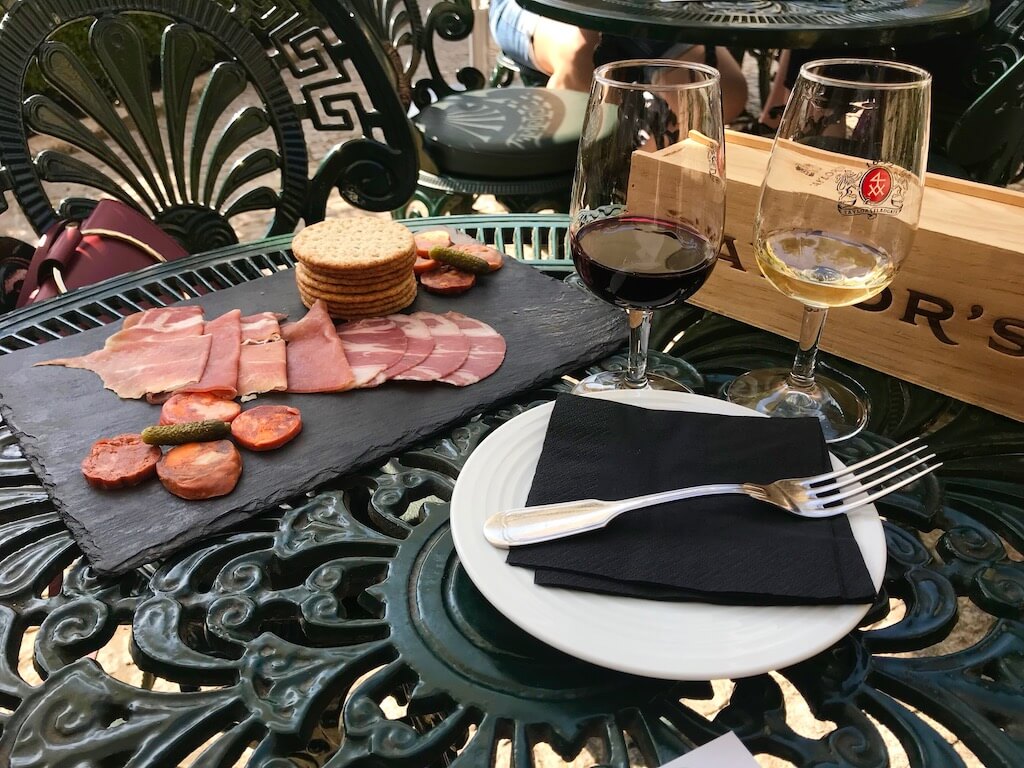
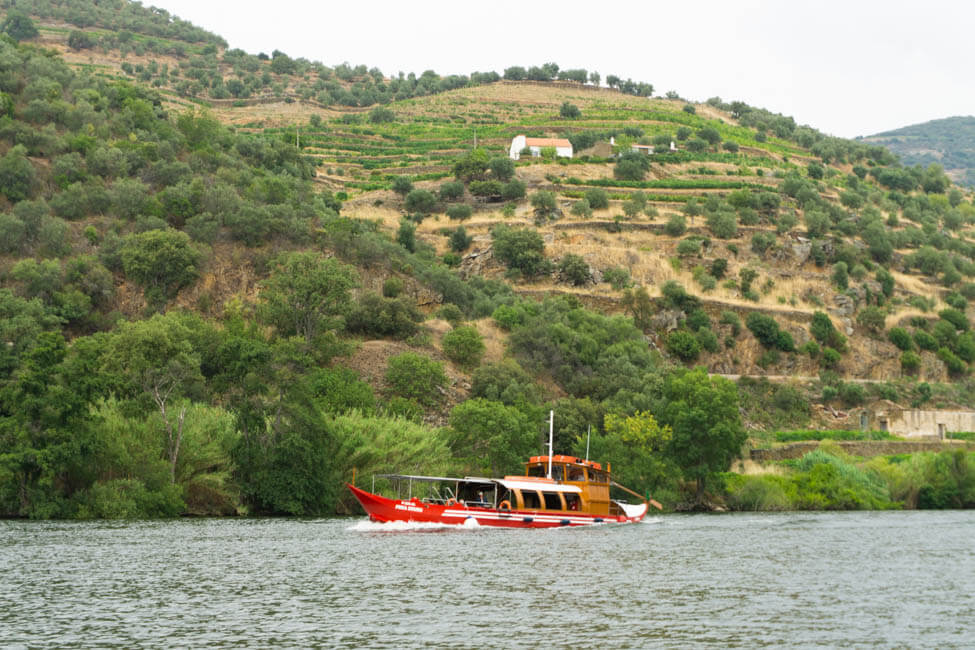
I am back from Portugal (got back home on Monday) and missing the country and Porto a lot. I stayed three days in Porto and felt like I could have extended my stay. The negative was that it was raining for the first two days we were there. That didn’t stop us but it was a bit of a bummer. I can’t wait to be back and see more of Porto and of the northern part of the country.
I hear you, Ruth! I feel just the same way. I spent a week in Porto, but was ill at the time which slowed me down. We will both just have to go back!
We are preparing for a trip to Portugal in October and your post made me so excited!!
Daisy—It’s going to be AH-mazing! 🙂 I’m so glad the post was helpful. Thanks so much for letting me know 🙂 Have an incredible time! Chris
HI There,
Great Itinerary . Wanted to ask if you had a 3rd day reccomended if you don’t go to the Valley ( non-drinker the last 8 years). What would be a good day spent ? or would a day trip be the way to go? I have 3 3 full days and a full 1/2 day ( arrival day) to spend before leaving.
Thanks for any suggestions 🙂
Hi Don, Consider going to the the valley even if you don’t drink. The terraced hillsides make it a unique and gorgeous landscape that I haven’t seen anywhere else. Plus, if you go on my recommended tour, it also includes a lovely lunch and boat ride down the river. Otherwise, take a sailboat tour on the river in Porto!
Hi Chris
Thanks for all of your information on Porto, I really appreciate it. I am planning a 4 day trip to Porto with my husband & 2 grown sons. It will be in aug 2023. We are on a budget but Its a birthday celebration for my husband (a significant one !!) & we would like it to be a ‘family celebration I know that hubby will love Porto, its cathedrals, history, scenery & e’verything else. I would really appreciate any thoughts you may have however on whether it would be interesting for a 23 year old & a 24 year old who are quite fit but may not be enthused about viewing alot of cathedrals & walking daily. Would it be easy to get to Lisbon or anywhere else for a day trip?
Hi Lillian, Porto is my favorite city in Portugal. It’s hard to imagine anyone not being charmed by it! The best day trip from Porto is wine tasting in the Douro Valley. Otherwise, plan a boat ride down the river from Porto. The steep terraced vineyards from the river are quite a site! Unfortunately, Lisbon is too far for a day trip but makes a great first or last stop in Portugal.
Hello! We’re traveling to Porto in February from the US. Your suggestions on where to eat are so helpful and I’m curious about what times you would suggest for meals? (Recognizing schedules are a bit different!)
Hi Sam, Much like Spain, Portugal tends to eat later in the evening, around 9 pm although you’ll also find plenty of restaurants open a bit earlier!
Such great tips!!
We plan on going to Portugal for 7 days. Defiantly will go to Porto. Can you suggest other cities for our trip and in what order to visit? We will then continue on to Croatia. We visit family in Croatia every Summer and have started doing pre-Croatia visits to other great European destinations.
Thank you so much!!
Tanja
Hi Tanja, Lisbon also makes a great base for day trips. I loved our day trip to Sintra and honestly, there are so many castles there and it’s so beautiful, I’d highly recommend an overnight. You can catch a fast train between Lisbon and Porto easily. I haven’t been to the Algarve yet but the beaches there are supposed to be fantastic! Enjoy 🙂